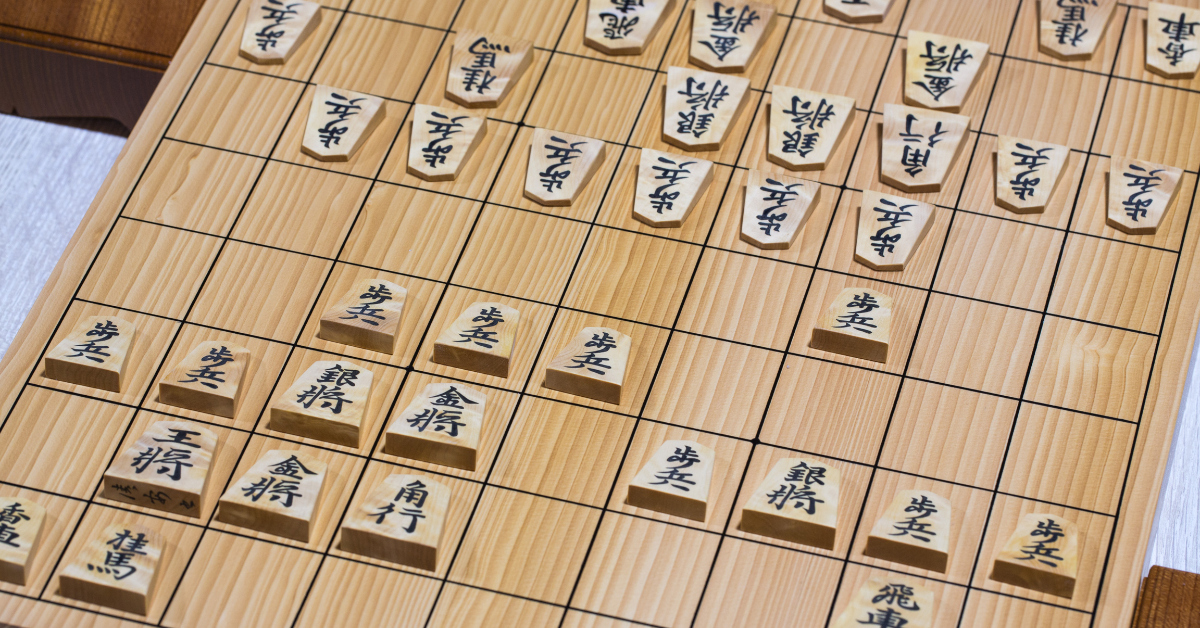Shogi is Japan’s traditional board game, often compared to chess yet developed in its own unique way. Its greatest feature is the rule that allows players to reuse captured pieces. Rich in strategy and comebacks, Shogi is an essential gateway to understanding Japanese culture.
Basic Overview of Shogi
Shogi is a two-player strategic game, and the objective is to checkmate the opponent’s King. The board consists of 9×9 squares, making a total of 81 squares.
The game flow can be divided into three stages:
- Opening – Deploying pieces while reinforcing defense
- Middle game – Attacks and defenses become more complex and tactical
- Endgame – Promotions and the reuse of captured pieces create frequent comebacks
A single match can last several hours, requiring concentration and endurance throughout.
Types of Pieces and Their Movements
Each Shogi piece has unique movements, and when they enter the opponent’s territory, they can be promoted, significantly changing their abilities. This system makes the game increasingly dynamic toward the end.
| Piece | Movement | After Promotion |
|---|---|---|
| King | One square in any direction | Cannot promote |
| Gold General | One square forward, backward, sideways, and diagonally forward | Cannot promote |
| Silver General | One square forward and diagonally forward | Promotes to move like a Gold General |
| Knight | Jumps forward two squares and one to the side | Promotes to move like a Gold General |
| Lance | Moves forward any number of squares | Promotes to move like a Gold General |
| Pawn | Moves forward one square | Promotes to “Tokin,” moves like a Gold General |
| Rook | Moves any number of squares vertically or horizontally | Promotes to “Dragon King,” adds one-step diagonal moves |
| Bishop | Moves any number of squares diagonally | Promotes to “Dragon Horse,” adds one-step orthogonal moves |
Even the smallest piece, the Pawn, can become powerful once promoted, making it critical in determining the outcome of the game.
Differences Between Shogi and Chess
Shogi and chess share the common objective of checkmating the opponent’s king, but there are significant differences.
| Aspect | Shogi | Chess |
|---|---|---|
| Board | 9×9 (81 squares) | 8×8 (64 squares) |
| Number of pieces | 20 per player | 16 per player |
| Captured pieces | Can be reused by the captor (drop rule) | Removed from play permanently |
| Promotion | Pieces promote when entering enemy territory | Promotion usually results in a Queen |
| Game flow | Frequent comebacks possible | Early advantages often decide the outcome |
Because of the drop rule, Shogi is seen as a game where the outcome remains uncertain until the very end, making it highly thrilling.
History and Cultural Background of Shogi
Shogi is believed to have originated from the ancient Indian game Chaturanga and spread through China and Korea before reaching Japan. Records show that it was already played during the Heian period, and by the Edo period, it had spread widely among the common people.
Shogi was not only a pastime but also a training tool for samurai strategy, symbolizing intellectual contests.
Today, professional tournaments and title matches are broadcast on TV and online, drawing large audiences. With the rise of star players such as Sota Fujii, who holds multiple major titles, Shogi has gained increasing attention both domestically and internationally.
Shogi Strategies and Tactics
Shogi offers a wide variety of strategies, requiring players to adapt flexibly to their opponent’s moves. Below are some representative ones:
| Strategy | Characteristics | Suitability for Beginners |
|---|---|---|
| Yagura Castle | Solid defense with balanced offense | Intermediate players |
| Mino Castle | Strong against side attacks | Easy for beginners to learn |
| Ranging Rook | Moves the rook to the left for flexible attacks | Suitable for players seeking versatility |
| Static Rook | Keeps rook in place for direct central attacks | A core strategy worth learning |
While strategies are important, ultimately it is calculation and reading ability that determine victory, making actual playing experience indispensable.
The Professional Shogi System and Title Matches
The world of Shogi has a professional system, operated by the Japan Shogi Association. To become a pro, one must join the apprentice school (Shoreikai) and advance through fierce competition.
Professional players compete in prestigious title matches, which attract significant public attention.
| Title | Characteristics | Prize Scale |
|---|---|---|
| Meijin | The most traditional and prestigious title | High |
| Ryuo (Dragon King) | Offers the highest prize money | Top-level |
| O-i, O-za, Ki-o, Ei-o | Annual major titles | Medium scale |
| Kisei | A best-of-five match | Relatively short-term |
Holding multiple titles simultaneously is extremely rare and considered a monumental achievement.
Ways to Experience Shogi
For foreigners wishing to start learning Shogi, there are various options:
- Books and educational materials – Introductory guides, even picture books for children, make learning fun.
- Shogi classes and dojos – Found throughout Japan, offering direct instruction.
- Online platforms – Apps and websites allow matches against players worldwide.
For beginners, the best starting point is to learn the movements of each piece. After that, gradually study strategies and standard openings, and watch professional matches to deepen understanding.
Conclusion
Shogi is a symbol of Japanese culture, combining entertainment with intellectual depth.
- The drop rule makes every game unpredictable until the end
- The promotion system adds dynamic changes to piece power
- With its rich history, Shogi has been loved by samurai, commoners, and now international audiences
For foreigners, Shogi provides not only an enjoyable pastime but also an entry point into Japanese culture, fostering logical thinking, strategic judgment, and patience.






